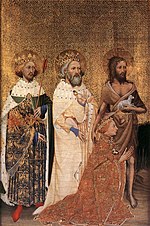Wilton Diptych
The Wilton Diptych is an altarpiece created between 1395 and 1399 . The picture painted with tempera on oak is approx. 47 × 60 cm in size. It is located in the National Gallery in London .

|

|
|
|
|
|
|
|
Provenance
The picture was first recorded in an inventory of Charles I's art collection in 1649 as a gift from Sir James Palmer. From there it ended up in the collection of the Earl of Pembroke , who kept it in Wilton House . The picture stayed there from 1705 to 1929. Wilton House is the namesake of the Wilton diptych. The National Gallery acquired the painting in 1929.
Image description
The diptych was commissioned by Richard II . The frame of the picture is made of the same oak wood as the picture panels. It is just as gilded as the hooks and eyes with which the folded panels could be closed.
Richard II is shown kneeling on the left, behind him are three saints who present him to the Madonna and who can be identified by their attributes . There are Richard's namesake John the Baptist with a fur throw and a lamb on his arm, and the English kings Eduard the Confessor and Edmund of East Anglia , both in ermine cloaks and with crowns on their heads. On the right side you can see the Madonna with the child, who turns to the kneeling king with a gesture of blessing. You are surrounded by a tightly packed group of angels. One of the angels carries the flag with the English Saint George's Cross , which flutters in an exposed position high above the angel's wings. England is represented as a small island on the small ball on top of the flagpole, a symbol for the globe. The robes of the angels are embroidered on the shoulder with a white stag, the emblem of Richard II. The meadow floor, on which the Madonna and angels are located, is covered with roses, irises and daisies, which are typical symbols of Mary , but which also symbolize paradise .
Both groups are painted on a punched gold background . The coat of arms of Richard II and his emblem, the white stag with a crown collar and chain, can be seen on the outside.
The picture symbolically represents the entrustment of the King to England by the Christ child. It can be interpreted as a sign of the “God-given” claim of the crown to worldly supremacy over the church.
Master of the Wilton Diptych
The name of the painter of the Wilton Diptych is unknown. He is therefore referred to with the emergency name Master of the Wilton Diptych .
